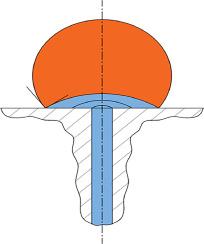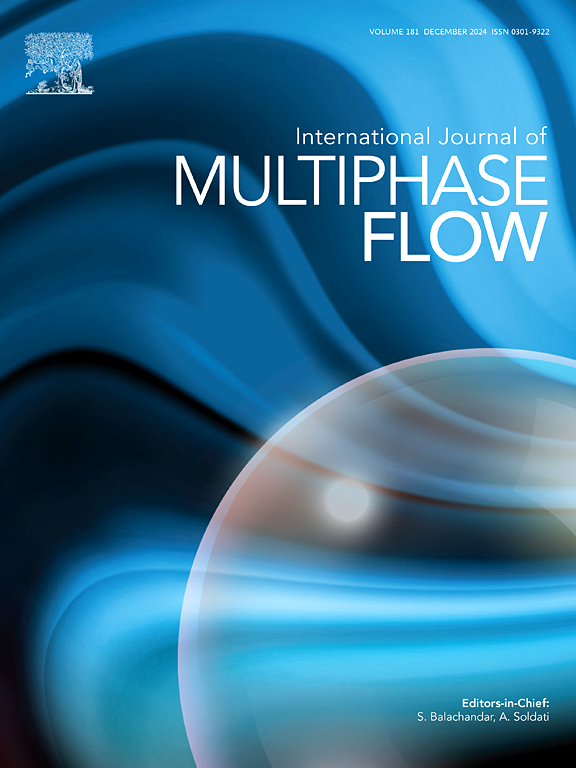关于毛细管中新出现的液滴在平面上被润湿蛞蝓终止的问题:一维准静态模型和 CFD 分析
IF 3.8
2区 工程技术
Q1 MECHANICS
International Journal of Multiphase Flow
Pub Date : 2024-09-25
DOI:10.1016/j.ijmultiphaseflow.2024.105010
引用次数: 0
摘要
液滴从孔隙喷射到储层的问题出现在许多领域,包括制药、食品、化工和其他一些行业。在这项工作中,我们有兴趣研究这种新出现的液滴开始脱落的过程。我们建立了一个一维模型,在准静态假设条件下描述了这一过程的动力学。模型忽略了流体惯性、接触角的动态性质以及入口和出口的流体动力学效应。流体惯性在位移过程的早期阶段可能很重要,之后其影响就会减弱。据推测,当与两个界面相关的两条接触线相交时,新出现的液滴将脱离表面。作用在该系统上的力包括外部压力、粘性力和毛细力。当前进的界面到达管道出口并开始发展时,流速会受到新出现的非润湿流体的毛细管压力的影响;当润湿流体开始取代润湿流体时,流速会受到两个界面的毛细管压力的影响。在开始发生位移时,两个界面上的毛细管压力相等。为了证实上述假设,并为验证和核实所开发的模型提供一个框架,我们进行了计算流体动力学(CFD)研究。CFD 模型描述了从注入非润湿流体到液滴喷射的整个过程。然而,该模型只考虑了润湿流体开始从管道出口进入储液器时的系统。模型与 CFD 分析之间的比较显示出良好的匹配性,这增强了对建模方法的信心。得出的结果非常有趣,尤其是当界面到达管道出口时。本文章由计算机程序翻译,如有差异,请以英文原文为准。

On the termination of an emerging droplet from a capillary tube over a flat surface by a wetting slug: A one-dimensional quasistatic model and CFD analysis
The problem of ejection of a droplet from a pore opening into a reservoir appears in many fields including pharmaceutical, food, chemical, and several other industries. In this work, we are interested in investigating the onset of dislodgment of such an emerging droplet. A one-dimensional model is developed that describes the dynamics of this process under quasistatic assumptions. Fluid inertia, the dynamic nature of the contact angle, as well as the entrance and exit hydrodynamic effects are ignored. Fluid inertia may be important at the very early stage of the displacement process, after which its effect diminishes. It is hypothesized that the emerging droplet will dislodge the surface when the two contact lines associated with the two interfaces meet. The forces acting on this system include external pressures, viscous and capillary forces. The flow rate is influenced by the capillary pressure of the emerging nonwetting fluid when the advancing interface reaches the exit of the tube and starts to develop, then by the two interfaces when the wetting fluid starts to displace the wetting one. At the onset of dislodgment, the capillary pressure across the two interfaces equalizes. A computational fluid dynamics (CFD) study has been conducted to confirm the stated hypothesis and to provide a framework for the validation and verification of the developed model. The CFD model depicts the whole spectrum of processes involved from the start of injection of the nonwetting fluid towards the ejection of the droplet. The model, however, only considers the system when the wetting fluid starts to emerge from the exit of the tube into the reservoir. Comparisons between the model and the CFD analysis show a good match, which builds confidence in the modeling approach. Interesting results are obtained, particularly when the interfaces reach the exit of the tube.
求助全文
通过发布文献求助,成功后即可免费获取论文全文。
去求助
来源期刊
CiteScore
7.30
自引率
10.50%
发文量
244
审稿时长
4 months
期刊介绍:
The International Journal of Multiphase Flow publishes analytical, numerical and experimental articles of lasting interest. The scope of the journal includes all aspects of mass, momentum and energy exchange phenomena among different phases such as occur in disperse flows, gas–liquid and liquid–liquid flows, flows in porous media, boiling, granular flows and others.
The journal publishes full papers, brief communications and conference announcements.

 求助内容:
求助内容: 应助结果提醒方式:
应助结果提醒方式:


